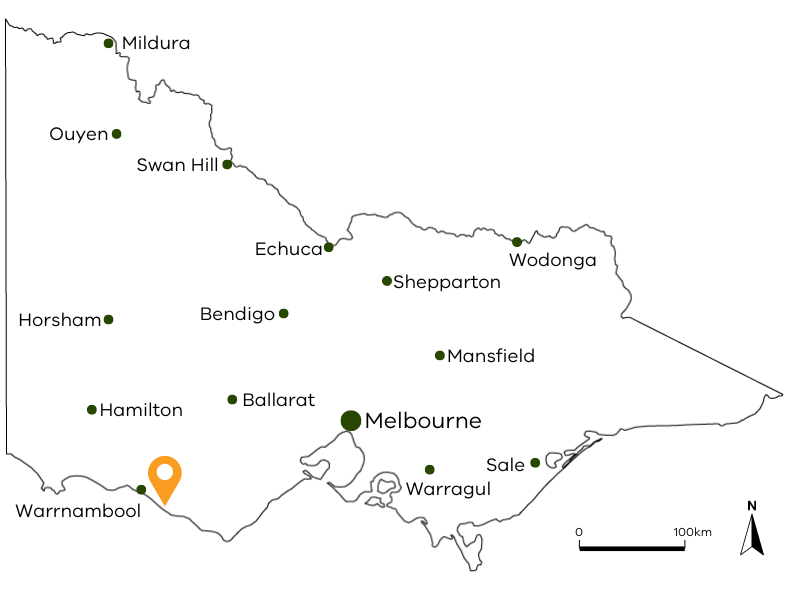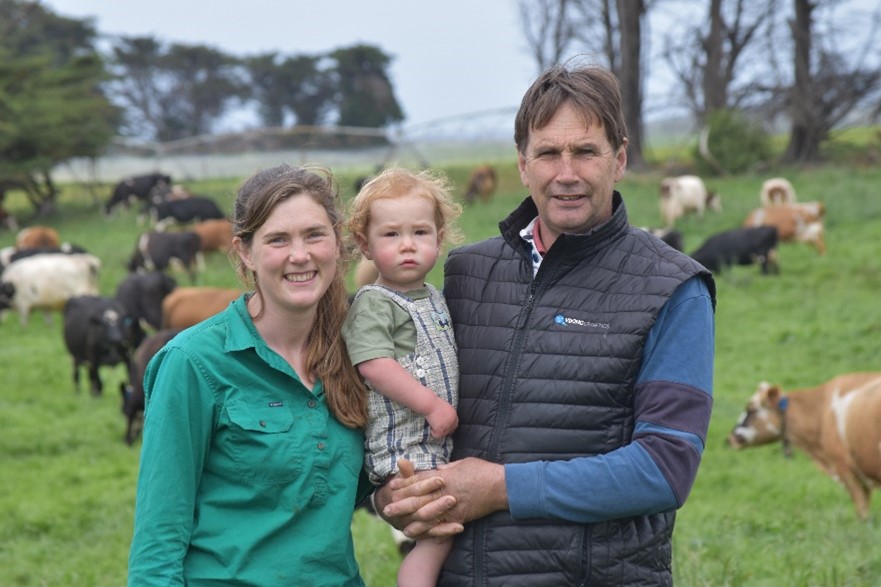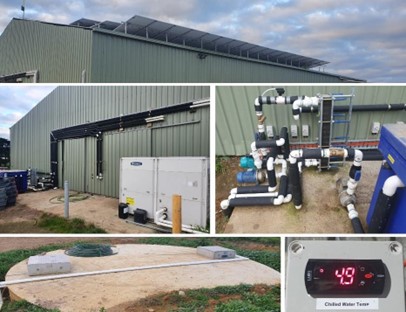Cool latte, use thermal storage!

About Ocean Road Pastoral
- Bruce, Andrea and Jordan Vallance are dairy farmers on a property in Nirranda, south-west Victoria.
- Ocean Road Pastoral is a dairy farm milking 850 cows on 516 ha.
- The milking area is 286 ha and there are 132 ha of centre pivot irrigated pasture.
- Perennial ryegrass forms the basis for pasture swards, with strategic application of nitrogen fertiliser to maintain growth and quality.
- Effluent from a three-pond system is applied through irrigation infrastructure and annual contract spreading.
- There are 10 ha of woody vegetation, approximately 15 years old, that provides shelter to stock across the farm.
- New dairy heat bank infrastructure is reducing grid-power consumption and carbon footprint.
Farming and carbon emissions
In Australia, there’s a big focus on how farms manage greenhouse gas (GHG) emissions and store carbon. Efficient production to manage and reduce emissions is becoming increasingly important.
Agriculture Victoria’s On-Farm Emissions Action Plan Pilot is working with Victorian farmers to know, understand and act on their farm GHG emissions.
For the Vallances, the goal is to have a sustainable and well-managed business that meets industry, consumer and business expectations of the future. Within this they have previously conducted energy audits for their farm and are working on reducing their reliance on grid electricity. This includes the progressive implementation of solar power generation, variable-rate irrigation and variable-speed drive within irrigation systems.
We decided to become involved with the Pilot to have data that was specific to our farm rather than just the broader industry. This will allow us to monitor changes based on our decisions.’
Ocean Road Pastoral farm is situated in Nirranda in south-west Victoria and is characterised by rolling rises with an average annual rainfall of 735 mm.

Regarding tackling farm emissions into the future, Jordan said, ‘Collaboration between farmers and researchers is needed to ensure that solutions are practical and profitable to all parties. Imparting this information then on to consumers means that they can better understand how the way we farm impacts the emissions profile of their food’.
Know Your Number
‘Know Your Number’ is a way to measure the greenhouse gas (GHG) emissions from a farm using a special tool like the Greenhouse Accounting Framework (GAF) calculator.
This number is the total amount of carbon dioxide equivalents (CO2-e) produced by the farm each year. It includes three types of emissions, called scopes:
- Scope 1: Emissions from livestock (like enteric methane from sheep and cows), nitrous oxide from nitrogen fertiliser application, urine and dung and carbon dioxide from fossil fuel use.
- Scope 2: Emissions resulting from the electricity the farm uses.
- Scope 3: Emissions created in manufacturing products the farm buys (embedded).
Farms can also capture and store carbon in trees and soils, a process known as carbon sequestration. This captured carbon can be used to balance against their emissions, which is called ‘insetting’.
For the Vallance’s farm, the emissions analysis for 2021–22 estimated that enteric methane from cows accounted for 58% of the net on-farm emissions, while the methane from animal waste added a further 18% of total farm emissions.
Nitrous oxide emissions from urine, dung and leaching accounted for around 15% of emissions. Carbon dioxide from electricity, lime and urea was 9% of the total emissions.
Ten hectares of trees provided a small (0.5%) inset advantage to the total farm emissions, where the current tree belts were estimated to capture 29 tonnes CO2-e per year, as well as providing valuable shade and shelter.
Emissions intensity
Emissions intensity measures the emissions (as CO2-e) per unit of product, reflecting production efficiency. It helps compare farms of different sizes. Ocean Road Pastoral’s milk production emission intensity was 1.05 kg CO2-e per kg FPCM, being just above the industry average for south-west Victoria, of 0.92 kg CO2-e per kg FPCM (fat and protein corrected milk). This is likely due to nitrogen and irrigation use for the specific year of analysis.
For meat production, associated with fattening steers and culled cows within the business, the emission intensity was 4.2 kg CO2-e per kg LW1 (liveweight) and was equivalent to the national industry average for dairy beef (4.2 kg CO2-e per kg LW).
Jordan said, ‘As commercial farmers, emissions intensity is a key driver for us as it reflects our overall efficiency’.
Acting to reduce emissions
For the Vallance’s enterprise, additional action to reduce reliance on grid electricity in their dairy operation represents an opportunity to reduce associated carbon dioxide emissions, which were 7% of their total annual emissions.
A Pilot Action Plan Grant is supporting the installation of additional solar photovoltaic panels coupled with thermal storage infrastructure for cooling milk at the time of milking. It is expected that the thermal storage project will reduce the average daily running costs by at least 50%.
Jordan explains that using power during peak solar production to cool bore water, which is used in the first bank of the milk plate cooler, is an efficient use of renewable power. The milk is cooled from 38 °C to 18–22°C. Subsequently, at the second bank, using a glycol solution, the milk temperature is further reduced to 4–7 °C.
Jordan said, ‘For us, a thermal storage system is preferable to battery storage, as batteries have a large initial investment cost, a limited lifespan and problematic disposal compared with a thermal storage system’.

Over the longer term, Jordan said, ‘the farm will continue to investigate options for management of methane emissions’.
The Pilot assessment identified progressive management options, including infrastructure upgrades to be feed additive-ready, as well as herd and breeding improvements that will target the emissions intensity of livestock.
Other opportunities for insetting emissions can come from establishing tree belts, which will have the added benefit of increasing farm biodiversity, shelter and shade for cattle and preserving waterways.
The future
Regarding the Pilot program and the future, Jordan said, ‘Tapping into a growing consumer demand for high-quality, sustainable dairy products, both domestically and in the export market, will help our industry expand and thrive while meeting evolving market expectations. The opportunities for dairy in capitalising on dairy beef is an exciting prospect.
‘We’re a commercial dairy farm and we’ve been able to integrate these sustainability measures into our business. Every strategy has to be able to stand alone, be profitable and have the added benefit of leaving the land in better condition. Sustainable farming practices are worth investing in to help future-proof Australian dairy.’
Acknowledgements
Author – James Nuttall, Agriculture Victoria, 2024
For further information on the project email actionplanpilot@agriculture.vic.gov.au
The On-Farm Emissions Action Plan Pilot is part of the Victorian Government’s Agriculture Sector Emissions Reduction Pledge to provide practical information, tools and services to support farmers to understand and reduce emissions.
The Pilot will work with up to 250 farm businesses across the state to estimate their on-farm emissions profile and identify potential actions to manage and reduce emissions while maintaining productivity and profitability.
References
1. Meat and Livestock Australia (2021). V.SCS.0016, Carbon accounting technical manual